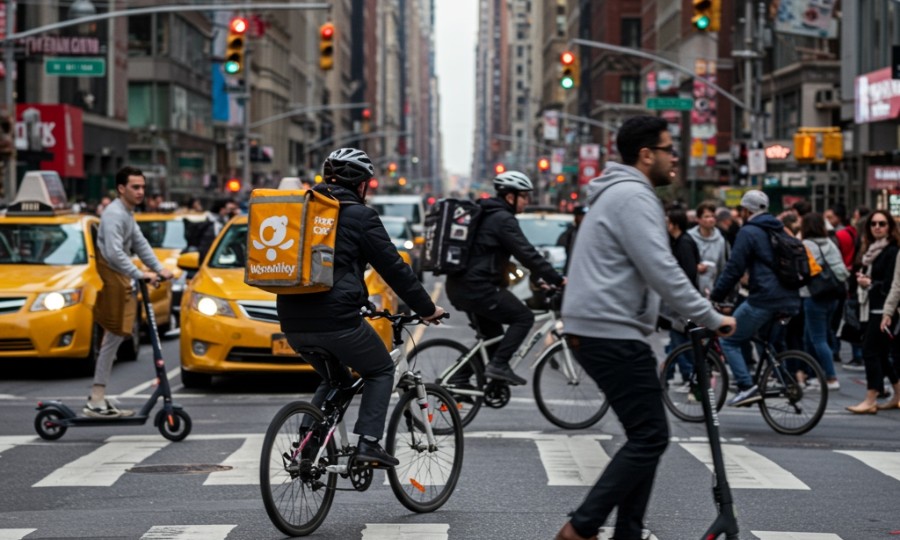
Ever feel like New York City streets are buzzing more than ever? It’s not just your imagination; the explosion of e-scooters and e-bikes has transformed our daily commutes and deliveries. While these nimble machines offer undeniable convenience and efficiency, they’ve also brought a sharp rise in accidents, creating a complex and often perilous landscape for riders, pedestrians, and motorists alike. We’re talking about more than just fender benders; serious injuries are becoming alarmingly common. So, how do you navigate this evolving legal maze when an accident inevitably happens?
The Rise of E-Mobility in NYC: A Double-Edged Sword
The scene is familiar: a delivery rider zipping past, a commuter effortlessly gliding through traffic, or tourists exploring on rented scooters. E-mobility has truly taken hold here in New York, offering a fast, eco-friendly way to get around our bustling city. The convenience is undeniable, particularly for the essential services that keep NYC running. But here’s the thing: with great accessibility often comes new risks, and the data paints a stark picture. According to the New York City Department of Transportation (DOT), incidents involving e-bikes and e-scooters have seen a significant uptick. While exact numbers can fluctuate, the trend is clear: more devices mean more interactions, and unfortunately, more collisions. This isn’t just about statistics; it’s about real people facing real injuries and the profound questions of who’s responsible when things go wrong.
Understanding the Accident Surge: What’s Happening on NYC Streets?
Why are we seeing this surge in accidents? It’s a confluence of factors, really. Many e-bikes and e-scooters can reach impressive speeds, sometimes exceeding 20 mph, which can be challenging to control in dense urban environments. Infrastructure often hasn’t caught up, leaving riders to contend with potholes, uneven surfaces, and a lack of dedicated lanes. Then there’s the human element: inexperienced riders, distracted pedestrians (we’ve all been guilty of looking at our phones while walking, haven’t we?), and drivers who simply aren’t accustomed to the rapid movements of these smaller vehicles. We’re seeing everything from “dooring” incidents (where a car door opens into an unsuspecting rider) to collisions at intersections and even bikes mounting sidewalks. It’s a chaotic mix, and frankly, it leaves many feeling frustrated and vulnerable, whether they’re on two wheels or two feet.
Navigating Liability: Who’s Responsible When Accidents Happen?
When an accident occurs involving an e-scooter or e-bike, the question of liability isn’t always straightforward. New York operates under a “pure comparative negligence” system. What does that mean for you? Essentially, if you’re found partially at fault for an accident, your ability to recover damages isn’t entirely barred; instead, your compensation would be reduced by your percentage of fault. For example, if you sustained $100,000 in damages but were deemed 20% responsible, you could still recover $80,000. This system is designed to be fair, but it also means that establishing fault requires meticulous investigation.
Consider these common scenarios:
-
E-Scooter Rider vs. Pedestrian: If a rider injures a pedestrian, the rider’s personal liability insurance (if they have it, which is often a big “if”) or even homeowner’s/renter’s insurance might come into play. However, if the pedestrian darted out suddenly, their own comparative negligence could reduce their claim.
-
E-Bike Rider vs. Car: This is often the most complex. A driver’s auto insurance policy will typically cover damages if the driver is at fault. But what if the e-bike rider ran a red light? Then it becomes a battle of percentages, and personal injury protection (PIP) benefits from the car’s policy might still apply to the rider’s medical expenses, regardless of fault, under New York’s no-fault law – a critical detail many don’t realize.
-
Rental E-Scooter Incidents: What about those shared e-scooters you rent via an app? Liability can get murky here. The rental company’s terms of service often try to shift all responsibility to the rider, but depending on the specific circumstances – like a poorly maintained scooter or a defect – the company itself might bear some blame. It’s a legal gray area that’s still being defined in courtrooms.
The truth is, determining who’s at fault requires an in-depth look at traffic laws, right-of-way, driver/rider conduct, and sometimes even vehicle maintenance records. It’s incredibly challenging to navigate these waters alone, especially when you’re recovering from an injury.
Insurance Realities for E-Bikes and E-Scooters
You might be thinking, “Does my regular insurance cover this?” And that’s a really good question, because the answer often depends. Unlike traditional motorcycles, e-bikes and e-scooters generally aren’t considered “motor vehicles” in the same way, which can leave a frustrating gap in coverage. Your standard auto insurance usually won’t cover your e-bike if you’re riding it, unless it’s explicitly added or meets very specific criteria. Sometimes, a homeowner’s or renter’s policy might offer limited liability coverage if you’re found at fault for injuring someone, but it rarely covers damage to your own device or your medical bills. This lack of clear, consistent coverage is a major concern for many riders and can leave victims of accidents with substantial out-of-pocket expenses. It’s definitely something to look into before you need it.
Priscilla’s Law and Beyond: Proposed Regulations Shaping the Future
Recognizing the growing safety concerns, New York City and State lawmakers are actively working to adapt the legal framework. One significant example, often discussed in the context of improving safety for pedestrians and other road users, is “Priscilla’s Law.” While the specifics of such legislation can evolve rapidly (and it’s always wise to check current legal statuses), a proposed law like Priscilla’s often aims to address critical gaps. Typically, it might propose stricter regulations on e-bike and e-scooter operation, such as mandatory speed governors for certain models, improved lighting requirements, or even new licensing or registration processes. The intent is clear: to enhance accountability and reduce the risk of serious injury.
For instance, such a law could:
-
Mandate Safety Features: Requiring certain reflective gear, brighter lights, or audible warnings could make riders more visible and prevent nighttime collisions.
-
Implement Speed Restrictions: Capping speeds in certain zones, particularly in high-pedestrian areas, could significantly reduce the severity of impacts.
-
Clarify Parking and Operation Zones: Designating clear areas for e-scooter and e-bike use and parking could reduce sidewalk clutter and pedestrian hazards.
These proposed regulations, like Priscilla’s Law, aren’t just about penalizing riders; they’re about creating a safer environment for everyone sharing our crowded streets. They reflect a growing understanding that our existing traffic laws, designed for cars and traditional bicycles, don’t always fit the unique challenges posed by e-mobility. It’s a complex balancing act, ensuring convenience isn’t sacrificed for safety.
What You Can Do: Protecting Yourself on NYC Streets
Given this dynamic environment, what steps can you take to protect yourself?
-
For Riders: Always wear a helmet (it’s the law for many e-bikes and e-scooters, depending on speed and classification!), obey traffic signals, and be predictable. Assume drivers and pedestrians don’t see you. Defensive riding isn’t just a suggestion; it’s a necessity. Consider personal liability insurance specifically designed for e-vehicles, as your homeowner’s policy might not be enough.
-
For Pedestrians: Stay alert. Avoid distractions. While you have the right-of-way in many situations, vigilance is your best defense. If you’re involved in an incident, document everything: take photos, get contact information, and seek medical attention immediately, even if you feel fine.
-
After an Accident: Regardless of whether you’re a rider, pedestrian, or driver, if an accident involves an e-bike or e-scooter, it’s crucial to gather evidence. Exchange information, get witness statements, and call the police if there are injuries or significant property damage. Most importantly, don’t admit fault.
The evolving legal landscape surrounding e-scooter and e-bike accidents in New York City is undeniably complex, and it can feel incredibly overwhelming, especially when you’re facing recovery from an injury. From determining fault under comparative negligence to navigating inadequate insurance coverages and understanding new regulations like Priscilla’s Law, there are many layers to peel back. You don’t have to face these challenges alone. Understanding your rights and the nuances of these laws is paramount to protecting your well-being and securing fair compensation. If you or someone you know has been involved in an e-mobility accident, seeking professional legal counsel isn’t just a good idea; it’s often the most critical step you can take to ensure your interests are fully protected. Don’t let the legal complexities prevent you from pursuing the justice you deserve.
Free Case Consultation
Injured in an accident? Contact Rosenberg, Minc, Falkoff & Wolff for a free and confidential case review with an experienced NYC personal injury attorney.


